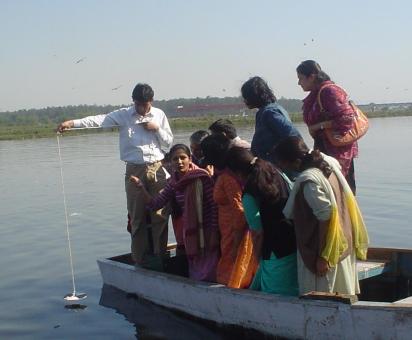Stars and STEM Stories
GLOBE India Implements Community-Based Water Monitoring Programme on the Yamuna River

Since the beginning of time, proximity to water has been essential to the birth, growth and spread of civilizations. Rivers, in particular, have spawned the growth of communities as sources of irrigation and channels of trade. Rivers often appear in the world's religious traditions for their mythic qualities, nourishing, cleansing, and sustaining life on their banks. In India, rivers are considered sacred.
The Yamuna River, one of the great rivers of India, extends some 1,370 kilometers from its pristine source in the Himalayas, through the densely populated plains of Uttar Pradesh to its confluence with the Ganges River and eventually into the Bay of Bengal. It flows directly through Delhi. The river provides irrigation and drinking water and generates electric power. Unfortunately, high density population growth, rapid industrialization, and ongoing deforestation have generated toxic components, making the water of the Yamuna hazardous for wildlife, fish, and as drinking water for humans.
Yamuna River pollution originates from 3 principle sources: households and municipal disposal sites, soil erosion resulting from deforestation occurring to make way for agriculture along with resulting chemical wash-off from fertilizers, herbicides, and pesticides and run-off from commercial activity and industrial sites.
To address these problems, the Ministry of Environment and Forests, the GLOBE coordinating agency in India, in partnership with the Indian Environmental Society (IES), implemented a programme designed to monitor water bodies using GLOBE hydrology protocols. They established a framework of commitments for local youths, school communities, and representatives from NGOs and residential welfare associations (RWAs) to restore and enhance water quality. The IES, a non- profit development organization, has been promoting environmental improvement initiatives since 1972. The organization is involved with environmental education, biodiversity conservation, information dissemination, and solid waste management.

In August 2006, a GLOBE Teachers Orientation Workshop was held in New Delhi, hosted by the IES and supported by the Ministry of Environment and Forests. The workshop introduced GLOBE hydrology protocols to 30 teachers from around the region. In addition, the workshop provided teachers with a general overview of how students can better understand their environment and contribute to scientific research. Another GLOBE training workshop was held March 14-16, 2007.
The purpose of the water monitoring programme is to disseminate knowledge of water pollution through water quality analysis. In doing so, teachers and students will develop skills that will help them create interest in preserving the environment from further deterioration, laying a foundation for a responsible society. The objective of the programme is to exchange information on recent developments, successes and challenges in reducing the impact of pollutants from the domestic and the industrial sectors. The programme also strives to strengthen commitments of various stakeholders in addressing the issues and implementing mitigation measures.
IES has initiated training workshops to educate teachers, students, and the local community, with an emphasis upon education as a key factor to community mobilization and participation. Turbidity or transparency, TDS (Total dissolved solids), conductivity, pH levels, water temperatures, oxygen dissolved, and alkalinity were the methodologies taught during the workshops. Employing these GLOBE hydrology protocols, the schools started to collect data from the Yamuna River, every fifteen days. The teachers continue to have follow-up meetings and workshops to address obstacles faced by both the teachers and students and to discuss their findings.
In addition to student and teacher participation, strong public and local involvement has been a focus of the Yamuna River Programme. The IES has initiated various awareness campaigns to encourage public participation, such as Nukkad Natak (Street Theater), demonstration camps, tree planting, women's programmes on conservation and water awareness, and the distribution of brochures to teachers, students and project beneficiaries containing information about water related issues. All these IES initiatives, with the involvement of the local community and schools, facilitate sustainability awareness and promote participation in addressing the water quality issues of the Yamuna River.
To learn more about the larger effort to restore the Yamuna River, please visit the National River Conservation Directorate's Yamuna Action Plan .
5 April 2007





